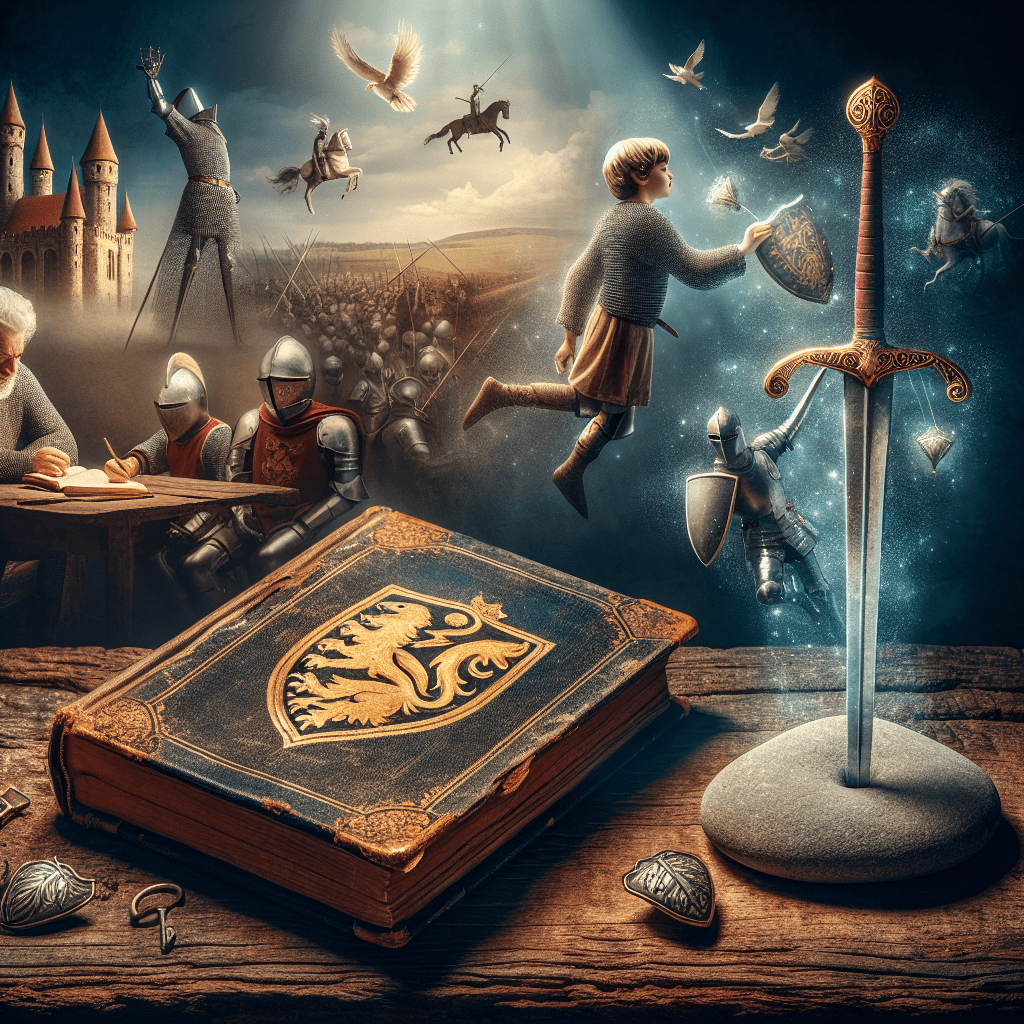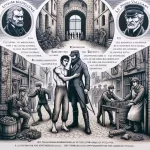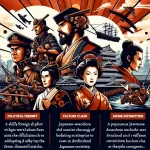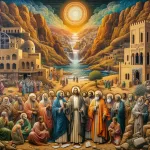-
Table of Contents
“Exploring the timeless journey of Arthurian legend: power, destiny, and the quest for identity in ‘The Once and Future King’.”
“The Once and Future King” is a novel by T.H. White that retells the legend of King Arthur, exploring themes of power, justice, and the complexities of human nature. The story is divided into four parts, chronicling Arthur’s upbringing, his rise to the throne, the establishment of the Round Table, and the eventual downfall of his kingdom. Key characters include Arthur, known as Wart in his youth; Merlin, his wise and eccentric mentor; Guinevere, his love interest; and Lancelot, his noble yet flawed knight. The novel delves into themes such as the moral implications of leadership, the struggle between good and evil, and the quest for identity, ultimately presenting a poignant reflection on the cyclical nature of history and the enduring quest for a just society.
Summary of The Once and Future King
“The Once and Future King,” a novel by T.H. White, is a retelling of the Arthurian legends that explores the life of King Arthur from his childhood to his eventual demise. The narrative is divided into four parts, each delving into different aspects of Arthur’s life and the complexities of his reign. The story begins with Arthur’s early years, where he is known as Wart, an orphan raised by Sir Ector. Wart’s formative experiences are shaped by his encounters with the enigmatic wizard Merlin, who serves as both mentor and guide. Through a series of transformative lessons, Merlin teaches Wart about the nature of power, justice, and the responsibilities that come with leadership. These lessons are conveyed through magical transformations, where Wart is turned into various animals, each experience imparting crucial insights into the human condition.
As Wart matures, he eventually pulls the sword Excalibur from the stone, a feat that marks him as the rightful king of England. This pivotal moment not only establishes his legitimacy but also sets the stage for the challenges he will face as a ruler. The narrative then shifts to Arthur’s establishment of the Round Table, a symbol of equality and chivalry among his knights. This idealistic vision of governance is challenged by the complexities of human nature, as Arthur grapples with betrayal, loyalty, and the moral dilemmas that arise from his relationships with key figures such as Lancelot and Guinevere. The love triangle between Arthur, Lancelot, and Guinevere serves as a central conflict, highlighting the personal sacrifices and emotional turmoil that accompany the pursuit of noble ideals.
As the story progresses, the themes of power and its consequences become increasingly pronounced. Arthur’s attempts to create a just society are undermined by the very forces he seeks to control. The rise of Mordred, Arthur’s illegitimate son, symbolizes the inevitable decay of his utopian vision. This conflict culminates in a tragic confrontation that leads to the downfall of Camelot, illustrating the fragility of human aspirations in the face of betrayal and ambition. The narrative does not shy away from the darker aspects of human nature, emphasizing that even the noblest of intentions can lead to catastrophic outcomes.
In the final part of the novel, Arthur’s reflections on his life and reign reveal a profound sense of loss and disillusionment. The once-promising ideals of chivalry and justice are overshadowed by the realities of war and betrayal. Yet, even in despair, there is a glimmer of hope as Arthur contemplates the possibility of a future where his legacy might inspire a new generation. The cyclical nature of history is encapsulated in the notion of the “once and future king,” suggesting that while Camelot may fall, the ideals it represented could one day be revived.
In conclusion, “The Once and Future King” is a rich tapestry of themes that explore the complexities of leadership, the nature of power, and the enduring struggle between idealism and reality. Through the character of Arthur, White invites readers to reflect on the challenges of governance and the moral responsibilities that accompany authority. The novel serves as both a poignant commentary on the human condition and a timeless exploration of the quest for a just society, leaving an indelible mark on the landscape of Arthurian literature.
Major Themes in The Once and Future King
“The Once and Future King,” a seminal work by T.H. White, intricately weaves together themes that resonate deeply with the human experience. At its core, the narrative explores the complexities of power and governance, examining the moral responsibilities that accompany leadership. Through the character of King Arthur, White presents a vision of a ruler who aspires to create a just society, yet grapples with the inherent challenges of wielding authority. This theme of power is not merely about the throne; it delves into the ethical dilemmas faced by those in positions of influence, prompting readers to reflect on the nature of justice and the consequences of decisions made in the name of the greater good.
Another significant theme in the novel is the quest for identity and self-discovery. Arthur’s journey from a young boy named Wart to the legendary King of Britain symbolizes the universal struggle for personal growth and understanding. Throughout the narrative, Arthur encounters various mentors, including Merlin, who guide him in his quest for knowledge and wisdom. This mentorship highlights the importance of education and experience in shaping one’s character. As Arthur learns about the world and his place within it, readers are invited to consider their own paths to self-realization, emphasizing that identity is often forged through trials and tribulations.
Moreover, the theme of war and its consequences permeates the text, serving as a poignant reminder of the futility of conflict. White portrays war not as a noble endeavor but as a devastating force that brings suffering and destruction. The tragic outcomes of battles fought in the name of honor and glory illustrate the senselessness of violence. Through the character of Lancelot, who embodies the conflict between personal loyalty and the greater good, White critiques the romanticized notions of chivalry and heroism. This exploration of war invites readers to contemplate the moral implications of their actions and the broader impact of societal conflicts.
Additionally, the theme of love and its complexities is intricately woven into the narrative. The relationships between characters such as Arthur, Guinevere, and Lancelot reveal the multifaceted nature of love, encompassing loyalty, betrayal, and sacrifice. Guinevere’s affair with Lancelot serves as a catalyst for the unraveling of Arthur’s kingdom, illustrating how personal desires can clash with public duty. This exploration of love underscores the idea that human emotions are often fraught with contradictions, leading to both profound joy and deep sorrow. White’s portrayal of love challenges readers to consider the ways in which personal relationships can influence larger societal dynamics.
Lastly, the theme of fate versus free will emerges as a critical element in the narrative. Characters grapple with their destinies, questioning whether their paths are predetermined or shaped by their choices. Arthur’s struggle to fulfill his role as king while navigating the expectations placed upon him reflects the tension between individual agency and the forces of fate. This theme resonates with readers, prompting them to reflect on their own lives and the extent to which they control their destinies.
In conclusion, “The Once and Future King” is a rich tapestry of themes that explore the intricacies of power, identity, war, love, and fate. Through the lens of Arthur’s journey, T.H. White invites readers to engage with profound questions about morality, human relationships, and the nature of existence. The enduring relevance of these themes ensures that the narrative continues to resonate with audiences, making it a timeless exploration of the human condition.
Character Analysis of King Arthur
King Arthur, the central figure in T.H. White’s “The Once and Future King,” embodies the complexities of leadership, morality, and the quest for justice. As a character, Arthur evolves significantly throughout the narrative, reflecting the challenges and responsibilities that come with kingship. Initially introduced as a young boy, Arthur, or Wart as he is affectionately called, is unaware of his royal lineage. His upbringing under the care of Sir Ector and his experiences with Merlyn shape his character, instilling in him a sense of curiosity and a desire for knowledge. This formative period is crucial, as it lays the groundwork for his future as a ruler.
As Arthur ascends to the throne, he grapples with the ideals of chivalry and the practicalities of governance. His vision of a just and equitable society is rooted in the principles of the Round Table, which symbolizes unity and equality among knights. However, Arthur’s idealism is often challenged by the harsh realities of human nature and the political landscape of his kingdom. This tension between his noble aspirations and the imperfections of those around him is a recurring theme in the narrative. For instance, Arthur’s relationships with key figures such as Lancelot and Guinevere illustrate the complexities of loyalty and betrayal, further complicating his role as king.
Moreover, Arthur’s character is marked by a profound sense of responsibility. He is acutely aware that his decisions impact not only his own fate but also the lives of his subjects. This burden of leadership weighs heavily on him, leading to moments of doubt and introspection. As he confronts the consequences of his choices, Arthur’s internal struggles reveal his humanity, making him a relatable and multifaceted character. His journey is not merely one of external conquest but also an exploration of his moral compass and the ethical dilemmas that arise in the pursuit of power.
Transitioning from his youthful idealism to a more seasoned perspective, Arthur’s character arc reflects the inevitable disillusionment that often accompanies leadership. The disintegration of the Round Table serves as a poignant reminder of the fragility of his dreams. As his knights succumb to personal conflicts and betrayals, Arthur’s vision of a harmonious kingdom begins to unravel. This decline is emblematic of the broader theme of the cyclical nature of history, suggesting that even the most noble endeavors can falter in the face of human flaws.
In the latter part of the narrative, Arthur’s character is further tested by the encroaching darkness of war and the betrayal of those he holds dear. His confrontation with Mordred, his illegitimate son, encapsulates the tragic elements of his story. This conflict not only signifies a battle for the throne but also represents the culmination of Arthur’s internal struggles. Ultimately, Arthur’s acceptance of his fate and his willingness to sacrifice for the greater good highlight his growth as a character. He embodies the notion that true leadership often requires difficult choices and personal sacrifice.
In conclusion, King Arthur’s character in “The Once and Future King” serves as a profound exploration of the complexities of leadership, morality, and the human condition. His journey from an innocent boy to a burdened king illustrates the challenges inherent in the pursuit of justice and the impact of personal relationships on one’s ideals. Through Arthur, T.H. White invites readers to reflect on the nature of power, the weight of responsibility, and the enduring quest for a better world, making him a timeless figure in literature.
The Role of Merlin in The Once and Future King
In T.H. White’s “The Once and Future King,” the character of Merlin plays a pivotal role that extends beyond mere guidance for King Arthur; he embodies the complexities of wisdom, fate, and the interplay between knowledge and power. As a mentor to Arthur, Merlin serves as a bridge between the past and the future, imparting lessons that are both timeless and relevant. His character is steeped in the rich tapestry of Arthurian legend, yet White reinterprets him in a way that emphasizes his philosophical insights and moral dilemmas.
Merlin’s role as a mentor is crucial in shaping Arthur’s character and his vision for a just society. Through a series of transformative experiences, Merlin educates Arthur about the nature of power and the responsibilities that come with it. For instance, Merlin’s use of magical transformations allows Arthur to experience life from different perspectives, thereby instilling in him a sense of empathy and understanding. This method of teaching is not merely about acquiring knowledge; it is about fostering a deeper awareness of the complexities of human nature and the consequences of one’s actions. As Arthur grows, he learns that true leadership requires more than just strength; it demands wisdom, compassion, and a commitment to justice.
Moreover, Merlin’s character is intricately linked to the theme of fate versus free will. Throughout the narrative, he often speaks of the inevitability of certain events, suggesting that the future is predetermined. However, this notion is counterbalanced by the idea that individuals have the power to shape their destinies through their choices. This duality is particularly evident in Arthur’s journey, as he grapples with the weight of his responsibilities and the expectations placed upon him. Merlin’s guidance serves as a reminder that while fate may set the stage, it is ultimately the choices made by individuals that determine the course of their lives.
In addition to his role as a mentor, Merlin also embodies the tension between knowledge and power. His vast wisdom and magical abilities position him as a figure of authority, yet they also isolate him from the very world he seeks to influence. This paradox highlights the challenges faced by those who possess great knowledge; they often find themselves at odds with the ignorance and fear of others. Merlin’s struggles with this isolation are evident in his interactions with Arthur and other characters, as he attempts to impart his wisdom while navigating the complexities of human relationships. This theme resonates throughout the narrative, illustrating the delicate balance between enlightenment and alienation.
Furthermore, Merlin’s character serves as a harbinger of change, foreshadowing the eventual decline of Camelot. His foresight into the future reveals the fragility of Arthur’s utopian vision, suggesting that even the most noble intentions can lead to unintended consequences. This prophetic aspect of Merlin’s character adds a layer of poignancy to the story, as readers are left to ponder the cyclical nature of history and the inevitability of change.
In conclusion, Merlin’s role in “The Once and Future King” is multifaceted, encompassing the themes of mentorship, fate, knowledge, and the complexities of human relationships. Through his interactions with Arthur and the lessons he imparts, Merlin not only shapes the future king but also serves as a reflection of the broader human experience. His character invites readers to contemplate the nature of wisdom and the responsibilities that come with it, ultimately leaving a lasting impact on the narrative and its exploration of the human condition.
The Evolution of Lancelot’s Character
In T.H. White’s “The Once and Future King,” the character of Sir Lancelot undergoes a profound evolution that reflects the complexities of chivalry, loyalty, and personal identity. Initially introduced as a paragon of knightly virtue, Lancelot embodies the ideals of bravery and honor that are central to Arthurian legend. His early portrayal as a noble knight, devoted to King Arthur and the Round Table, establishes him as a figure of admiration. However, as the narrative unfolds, Lancelot’s character becomes increasingly multifaceted, revealing the internal conflicts that arise from his relationships and the moral dilemmas he faces.
One of the most significant aspects of Lancelot’s evolution is his tumultuous love affair with Queen Guinevere. This relationship serves as a catalyst for his character development, illustrating the tension between personal desire and loyalty to his king. Initially, Lancelot’s love for Guinevere is portrayed as a noble pursuit, one that elevates his status and adds depth to his character. However, as the story progresses, this love becomes a source of inner turmoil, leading to feelings of guilt and betrayal. The conflict between his passion for Guinevere and his allegiance to Arthur highlights the complexities of human emotion and the often-painful choices that accompany love.
Moreover, Lancelot’s journey is marked by a gradual realization of his own flaws and limitations. As he grapples with the consequences of his actions, he begins to question the very ideals he once upheld. This introspection is particularly evident in his encounters with other characters, such as the wise Merlin and the noble Arthur. Through these interactions, Lancelot confronts the reality of his imperfections, which ultimately leads to a deeper understanding of himself. This self-awareness is a crucial turning point in his character arc, as it allows him to evolve from a mere embodiment of chivalric ideals into a more relatable and human figure.
Additionally, Lancelot’s relationship with his fellow knights further illustrates his character’s evolution. Initially, he is seen as a leader among his peers, admired for his prowess in battle and his unwavering commitment to the chivalric code. However, as the narrative progresses, the strain of his secret love for Guinevere begins to alienate him from the other knights. This sense of isolation serves to highlight the internal conflict he faces, as he grapples with the consequences of his choices on both a personal and communal level. The camaraderie that once defined his relationships begins to fracture, leading to a poignant exploration of the loneliness that can accompany greatness.
Ultimately, Lancelot’s evolution culminates in a profound sense of loss and redemption. As the story reaches its climax, he is forced to confront the ramifications of his actions, leading to a poignant moment of reckoning. This journey from a celebrated knight to a figure marked by regret and introspection underscores the theme of the tragic hero, illustrating how even the most noble individuals can be ensnared by their desires and flaws. In this way, Lancelot’s character serves as a powerful reflection of the complexities of human nature, embodying the struggle between aspiration and reality, love and loyalty, and ultimately, the quest for self-understanding. Through Lancelot’s evolution, White invites readers to contemplate the intricate tapestry of human experience, where ideals often clash with the messy realities of life.
The Significance of Camelot in The Once and Future King
In T.H. White’s “The Once and Future King,” Camelot emerges as a symbol of idealism, a utopian vision of society that embodies the aspirations and values of King Arthur’s reign. The significance of Camelot extends beyond its physical presence; it represents the philosophical and moral underpinnings of Arthur’s quest for justice and equality. As the narrative unfolds, Camelot becomes a microcosm of the broader themes of power, governance, and the human condition, illustrating the complexities inherent in the pursuit of an ideal society.
Initially, Camelot is depicted as a beacon of hope, a place where chivalry and honor reign supreme. Arthur’s vision for Camelot is rooted in the principles of fairness and the belief that a ruler should serve the people rather than dominate them. This idealistic foundation is reflected in the Round Table, which symbolizes equality among the knights, eliminating hierarchies and fostering camaraderie. The Round Table serves as a physical manifestation of Arthur’s commitment to creating a society where every voice is valued, and every individual has a role to play in the greater good. This egalitarian ethos is central to the narrative, as it highlights the tension between idealism and the harsh realities of human nature.
However, as the story progresses, the initial promise of Camelot begins to unravel, revealing the fragility of Arthur’s vision. The internal conflicts among the knights, particularly the love triangle involving Lancelot, Guinevere, and Arthur, serve to illustrate the inherent contradictions within the ideals of Camelot. Lancelot’s betrayal and Guinevere’s infidelity not only challenge the notion of loyalty but also expose the vulnerabilities of human relationships. These personal conflicts mirror the larger societal issues that Camelot faces, suggesting that even the most noble intentions can be undermined by human flaws. Thus, Camelot becomes a site of both aspiration and disillusionment, reflecting the complexities of governance and the challenges of maintaining an ideal society.
Moreover, the significance of Camelot is further underscored by its eventual downfall. The disintegration of Arthur’s kingdom serves as a poignant reminder of the impermanence of utopian ideals. As the knights succumb to their baser instincts and the moral fabric of Camelot frays, the narrative raises critical questions about the nature of power and the limits of idealism. The fall of Camelot is not merely a tragic event; it is a cautionary tale about the dangers of hubris and the inevitability of human conflict. In this sense, Camelot transcends its role as a mere setting; it becomes a powerful symbol of the cyclical nature of history and the perpetual struggle between aspiration and reality.
In conclusion, the significance of Camelot in “The Once and Future King” lies in its dual role as a symbol of idealism and a reflection of human imperfection. Through its rise and fall, Camelot encapsulates the central themes of the narrative, illustrating the complexities of leadership, the fragility of human relationships, and the challenges of realizing a just society. Ultimately, Camelot serves as a poignant reminder that while the pursuit of an ideal may inspire greatness, it is also fraught with challenges that can lead to its undoing. In this way, Camelot remains a timeless emblem of both hope and caution, resonating with readers as they contemplate the nature of power, governance, and the human experience.
Q&A
1. **Question:** What is the main plot of “The Once and Future King”?
**Answer:** The novel follows the life of King Arthur, from his childhood as Wart, through his rise to power, the establishment of the Round Table, and the eventual downfall of his kingdom due to betrayal and personal conflicts.
2. **Question:** What are the central themes of “The Once and Future King”?
**Answer:** Key themes include the nature of power and leadership, the quest for justice, the conflict between idealism and reality, the importance of education, and the complexities of human relationships.
3. **Question:** Who is the main character in “The Once and Future King”?
**Answer:** The main character is King Arthur, who embodies the ideals of chivalry and justice but struggles with the burdens of leadership and personal relationships.
4. **Question:** What role does Merlin play in the story?
**Answer:** Merlin serves as Arthur’s mentor and guide, using magic and wisdom to teach him important lessons about life, leadership, and morality.
5. **Question:** How does the character of Lancelot contribute to the story?
**Answer:** Lancelot is a complex character who represents the ideals of knighthood but also embodies the flaws of betrayal and unrequited love, particularly in his relationship with Guinevere and his loyalty to Arthur.
6. **Question:** What is the significance of the Round Table in the novel?
**Answer:** The Round Table symbolizes equality and unity among Arthur’s knights, representing the ideal of a just and fair society where all voices are heard, contrasting with the eventual disintegration of that ideal due to personal and political conflicts.”The Once and Future King” by T.H. White is a retelling of the Arthurian legends, focusing on the life of King Arthur, his rise to power, and the ideals of chivalry and justice. The narrative explores themes of power, the nature of humanity, and the conflict between idealism and reality. Key characters include Arthur, who embodies the struggle between his noble aspirations and the harsh realities of leadership; Merlin, who represents wisdom and the complexities of fate; and Guinevere, whose relationships highlight the personal costs of political alliances. The story ultimately reflects on the cyclical nature of history and the enduring quest for a just society, suggesting that while the ideals of Camelot may be unattainable, the pursuit of them is a noble endeavor.





I’ve been browsing online more than three hours today, yet I never
found any interesting article like yours. It’s pretty
worth enough for me. In my opinion, if all web owners and bloggers made good content as you did, thee net will be much
more useful than ever before.